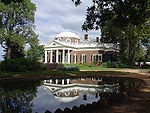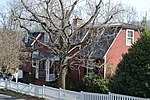Sunnyfields (Simeon, Virginia)
Albemarle County, Virginia Registered Historic Place stubsHouses completed in 1833Houses in Albemarle County, VirginiaHouses on the National Register of Historic Places in VirginiaNational Register of Historic Places in Albemarle County, Virginia

Sunnyfields is a historic home located between Monticello and Ash Lawn-Highland near Simeon, Albemarle County, Virginia. It was built in 1833, and is a two-story, nearly square brick structure painted white. It has a two-story corner tower, dating to either from just before or just after the American Civil War, and two-story, frame wing. Also on the property is a contributing servants' cottage. It was designed and built by William B. Phillips, who was employed by Thomas Jefferson as principal builder at the University of Virginia.It was added to the National Register of Historic Places in 1993.
Excerpt from the Wikipedia article Sunnyfields (Simeon, Virginia) (License: CC BY-SA 3.0, Authors, Images).Sunnyfields (Simeon, Virginia)
Thomas Jefferson Parkway,
Geographical coordinates (GPS) Address Nearby Places Show on map
Geographical coordinates (GPS)
| Latitude | Longitude |
|---|---|
| N 37.9925 ° | E -78.453055555556 ° |
Address
Thomas Jefferson Parkway
Thomas Jefferson Parkway
22902
Virginia, United States
Open on Google Maps






